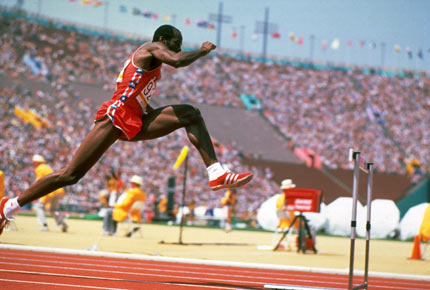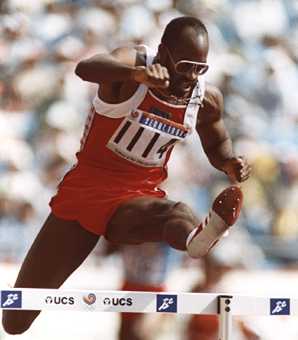A few weeks ago I received an email from a coach asking my thoughts on technique in the intermediate hurdle race, as compared to technique in the sprint hurdles. It was a very good question that I’ve debated about with people before. My opinion differs from the general consensus. Here is the response I gave to the coach:
“I’m of the opinion that there should be no difference in hurdling technique between the two races, except for the fact that you’ll lean less in the longer race because the hurdles are lower. But yes, keep the thumbs up, keep the elbows tight, snap down the lead leg, drive the trail leg up underneath the armpit. All of that. Conventional wisdom says let the lead leg float down, but I don’t agree with that. Snapping down actually takes less energy than floating down. In floating down, you may land closer to the next hurdle, but you won’t have as much velocity headed in that direction. So you’ll always be in the mode of losing speed and fighting to re-accelerate, whereas if you snap down you can rhythmically roll right through to the next hurdle with fluidity and ease. And by the end of the race, fatigue will be much less of a factor. Yeah, to me, the only difference is the lean. If you lean too much over the 30-inch or 36-inch hurdles, you’re just wasting energy because you can just step over them. But even so, you need to be driving forward, pushing the chest out. Even in the long hurdles you can’t be too erect between the hurdles or over the hurdles. By being too erect, you’ll be in danger of rocking back on your heels. Consequently, you’ll jump over the hurdles instead of driving through them.”
To elaborate on the email, let me add the following thoughts:
For a left-leg lead, technique on the curve is different from technique on the straight. On the curve, the right arm will cross the body. For a right-leg lead, technique has to be the same on the curve as it is on the straight in order to avoid hooking the trail leg.
It is true that intermediate hurdlers can get away with more technical mistakes than a sprint hurdler can. Simply put, because there is more space between the hurdles, there is more time to recover. A strong quarter-miler with weak hurdling skills can do much better in the intermediates than a strong 100m runner with weak hurdling skills can in the highs.
Despite what I just said in the above paragraph, the best intermediate hurdlers are great technicians. They have it all – strength, speed/endurance, flexibility, and technique. Watch film of Edwin Moses, Harald Schmid, Andre Phillips, Felix Sanchez, and you’ll see what I mean. Moses could’ve been a great 110 hurdler, and Phillips was.


Edwin Moses, at the 1984 (left) and 1988 Olympics (right), shows the form that made him the greatest 400m hurdler in history.
To use Moses as an example, it was obvious throughout his career that he could’ve twelve-stepped the second and third hurdles if he wanted to. But the longer take-off distance would’ve caused him to float. By sticking with thirteen in the early part of the race, he was able to establish a quick turnover in his running strides, and to take off close enough to the hurdle so that he could really snap down aggressively. Consequently, and paradoxically, I guess, he was conserving energy by taking more strides. With the quick tempo and quick snapdown early in the race, he was able to maintain a 13-step stride pattern throughout the race. If he had twelve-stepped early, he would’ve expended so much energy extending his stride and floating over those early hurdles that he might have been forced to drop down to a 14-step pattern late in the race.
Hey, it’s something to think about.
© 2007 Steve McGill
